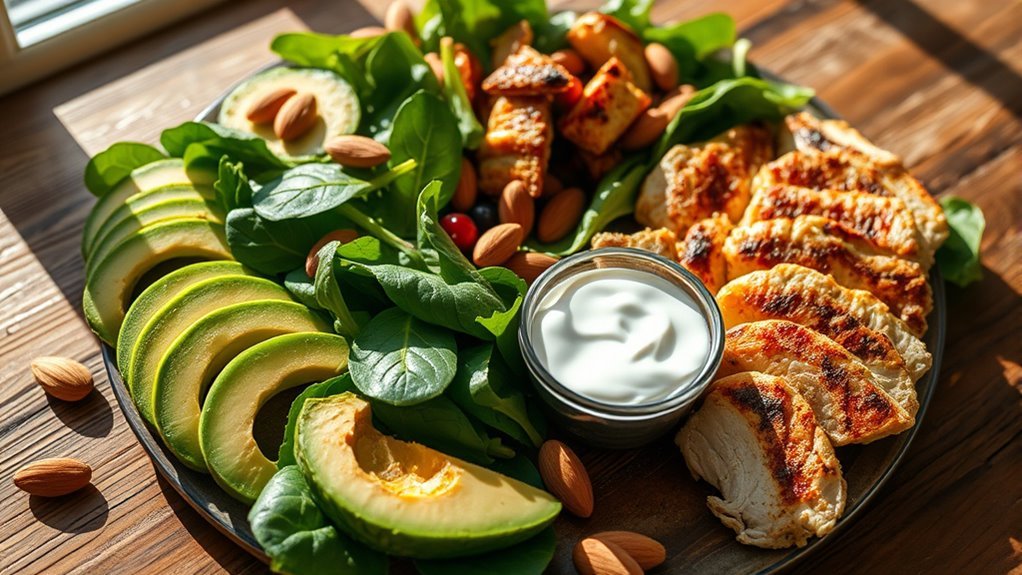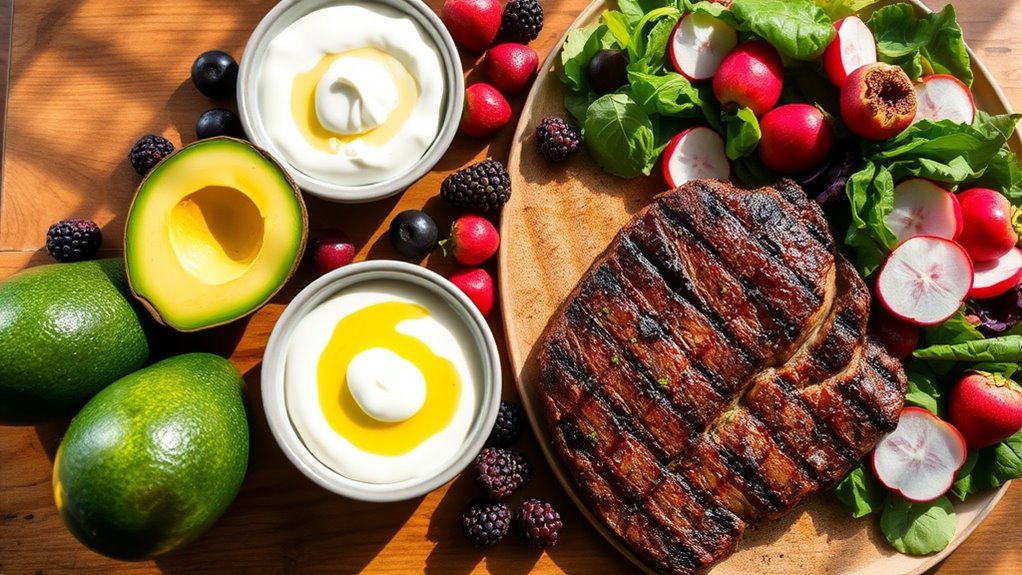The ketogenic diet plan is a low-carbohydrate, high-fat eating approach that shifts your metabolism from burning glucose to utilizing ketones for energy. Typically, this involves consuming about 70-75% fat, 20-25% protein, and only 5-10% carbohydrates. By entering ketosis, your body can efficiently burn fat, leading to rapid weight loss and enhanced mental clarity. However, it’s important to reflect on potential drawbacks. There’s much more to discover about the benefits and tips for successful adherence.
What Is the Ketogenic Diet?

The ketogenic diet, often referred to as keto, is a low-carbohydrate, high-fat eating plan designed to shift your body’s metabolism away from glucose and towards ketones, which are produced from fat. This macronutrient breakdown typically consists of around 70-75% fat, 20-25% protein, and only about 5-10% carbohydrates. By adhering to this ratio, you encourage your body to enter the ketosis process, where it becomes highly efficient at burning fat for energy. This not only helps in weight management but also promotes mental clarity and sustained energy levels. Understanding these fundamental principles can empower you to take control of your nutrition, allowing for a greater sense of freedom in your dietary choices while working toward your health goals.
Benefits of the Keto Diet

Numerous studies highlight the benefits of the keto diet, making it a popular choice for many seeking effective weight loss and improved health. By considerably reducing carbohydrate intake, your body enters a state of ketosis, where it burns fat for fuel. This process can lead to rapid weight loss, making it easier to achieve your goals. Beyond physical changes, many individuals report enhanced mental clarity and focus while following the keto diet. This cognitive boost is often attributed to the brain’s reliance on ketones, a more efficient energy source than glucose. Overall, the keto diet not only supports weight loss but also promotes a sharper mind, giving you the freedom to feel your best in daily life.
Potential Drawbacks and Risks

While many people experience success on the keto diet, it’s important to be aware of the potential drawbacks and risks associated with this eating plan. One significant concern is the risk of nutrient deficiencies, as the diet restricts various food groups, limiting your intake of essential vitamins and minerals. Over time, this can lead to health issues if not properly managed. Additionally, the long-term sustainability of the keto diet can be challenging for many. Adhering to such a restrictive plan may not be feasible in the long run, leading to potential weight regain or unhealthy eating patterns. It’s vital to evaluate your individual needs and consider a balanced approach to guarantee both short-term success and long-term health.
How to Get Started on Keto
Getting started on the keto diet requires some planning and preparation to guarantee a smooth conversion into this low-carbohydrate, high-fat lifestyle. Begin by understanding your daily macronutrient needs, as tracking macros is essential for success. This involves calculating your ideal fat, protein, and carbohydrate intake to maintain ketosis. Meal prepping can simplify your journey; prepare meals in advance to avoid the temptation of high-carb options. Stock your pantry with keto-friendly foods like avocados, nuts, and low-carb vegetables. Don’t forget to stay hydrated and consider electrolyte supplementation, as your body adapts. With these strategies in place, you’ll find the change to keto more manageable and empowering, revealing a new level of dietary freedom.
Tips for Success on the Keto Diet
To thrive on the keto diet, it’s vital to stay informed and adaptable as you navigate this new eating approach. Start with effective meal planning; this not only saves time but guarantees you stick to your carb limits. Consider prepping your meals for the week to avoid last-minute temptations. When grocery shopping, focus on whole, unprocessed foods like meats, dairy, and low-carb vegetables. Reading labels is essential—watch for hidden sugars and carbs in packaged items. Don’t forget to stay hydrated and replenish electrolytes, as this can help mitigate the “keto flu.” Finally, embrace flexibility; if you slip up, don’t be discouraged—just refocus and keep moving forward. Your journey to freedom in your eating habits is a continuous process.


